2018 MERCEDES-BENZ AMG GT COUPE tyre pressure
[x] Cancel search: tyre pressurePage 6 of 465

Driving and pa
rking ................................. 108
Driving ........................................................ 108
DY NA MIC SELECT switch ............................1 14
Au tomatic transmission .............................. 11 6
Re fuelling .................................................... 12 0
Pa rking ...................................................... .123
Driving and driving saf ety sy stems .............1 30
Ve hicle towing instructions ........................ .162 Instrument Display and on-board
comp uter.................................................. 16 3
Instrument display overview ...................... .163
Overview of the buttons on thesteering
wheel ..........................................................1 64
Operating the on-board computer .............. 16 4
Setting the design ....................................... 16 6
Setting the additional value range .............. 16 6
Overview of displa yson the multifunc‐
tion display .................................................1 67
Menus and submenus ................................. 167LINGU
ATRO NIC ......................................... 176
No tes on operating saf ety .......................... .176
Operation ....................................................1 76Using LINGU
ATRO NIC ef fectively ................ 178
Essential voice commands .......................... 178 Multimedia sy
stem .................................. 18 9
Overview and operation .............................. 189
Sy stem settings .......................................... 19 8
AMG TR ACKPA CE ...................................... 208
Na vigation ................................................... 213
Te lephone .................................................. .238
Online and Internet functions ..................... 264
Media ........................................................ .273
Ra dio .......................................................... 286
TV ............................................................... 289
Sound ......................................................... 297 Main
tenance and care ............................. 301
ASS YST PLUS service inter val display ........ .301
Engine compartment .................................. 302
Cleaning and care ....................................... 308 Breakdown assistance
.............................318
Emergency .................................................. 318
Flat tyre ...................................................... 319Battery (vehicle) ......................................... 325
To
w- starting or towing away ....................... 331
Electrical fuses ........................................... 335 Wheels and tyres
..................................... 338
No tes on noise or unusual handling char‐
acteristics .................................................. .338
No tes on regular lyinspecting wheels and
tyres .......................................................... .338
No tes on snow chains ................................ 338
Ty re pressure .............................................. 339
Wheel change ............................................ .346
Collapsible spa rewheel .............................. 356 Te
ch nical data .......................................... 359
No tes on tech nical da ta.............................. 359
On-board electronics .................................. 359
Ve hicle identification plate, VIN and
engine number ...........................................3 59
Operating fluids .......................................... 360
Ve hicle data ................................................ 366 Contents
3
Page 12 of 465
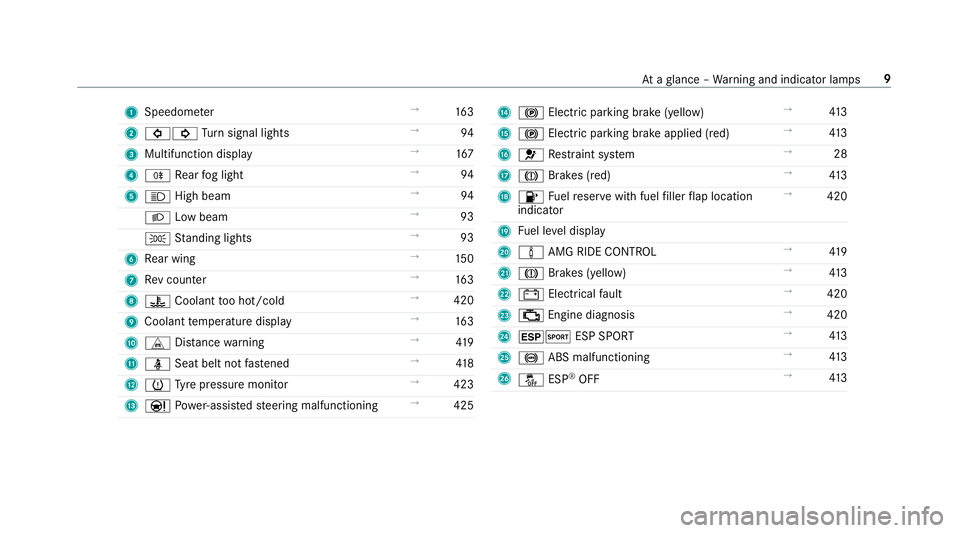
1
Speedom eter →
16 3
2 #! Turn signal lights →
94
3 Multifunction display →
167
4 R Rear fog light →
94
5 K High beam →
94
L Low beam →
93
T Standing lights →
93
6 Rear wing →
15 0
7 Rev counter →
16 3
8 ? Coolant too hot/cold →
420
9 Coolant temp erature display →
16 3
A L Distance warning →
419
B ü Seat belt not fastened →
41 8
C h Tyre pressure monitor →
423
D Ð Powe r-assis tedsteering malfunctioning →
425 E
! Electric pa rking brake (yellow) →
413
F ! Electric pa rking brake applied (red) →
413
G 6 Restra int sy stem →
28
H J Brakes (red) →
413
I 8 Fuelreser vewith fuel filler flap location
indicator →
420
J Fuel le vel display
K à AMG RIDE CONTROL →
419
L J Brakes (yell ow) →
413
M # Electrical fault →
420
N ; Engine diagnosis →
420
O ±M ESP SPORT →
413
P ! ABS malfunctioning →
413
Q å ESP®
OFF →
413 At
aglance – Warning and indicator lamps 9
Page 20 of 465
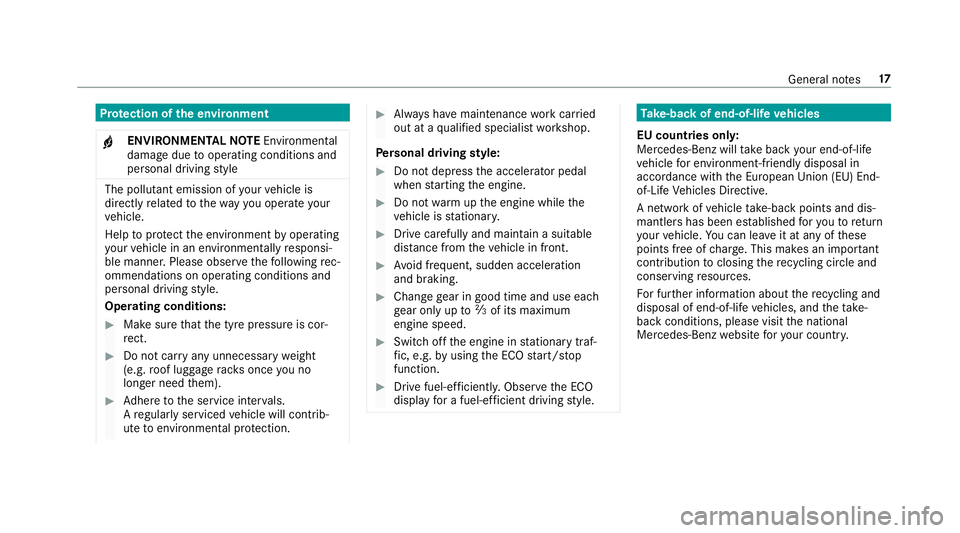
Pr
otection of the environment
+ ENVIRONMENTAL
NOTEEnvironmental
dama gedue tooperating conditions and
personal driving style The pollutant emission of
your vehicle is
directly related tothewa yyo u operate your
ve hicle.
Help toprotect the environment byoperating
yo ur vehicle in an environmentally responsi‐
ble manner. Please obser vethefo llowing rec‐
ommendations on ope rating conditions and
pe rsonal driving style.
Operating conditions: #
Make sure that the tyre pressure is cor‐
re ct. #
Do not car ryany unnecessary weight
(e.g. roof luggage rack s once you no
lon ger need them). #
Adhere tothe service inter vals.
A regularly serviced vehicle will contri b‐
ute toenvironmen tal pr otection. #
Alw ays ha vemaintenance workcar ried
out at a qualified specialist workshop.
Pe rsonal driving style: #
Do not depress the accelera tor pedal
when starting the engine. #
Do not warm upthe engine while the
ve hicle is stationar y. #
Drive carefully and maintain a suitable
di st ance from theve hicle in front. #
Avoid frequent, sudden acceleration
and braking. #
Change gear in good time and use each
ge ar on lyup toÔ of its maximum
engine speed. #
Switch off the engine in stationary traf‐
fi c, e.g. byusing the ECO start/ stop
function. #
Drive fuel-ef ficiently. Obser vethe ECO
display for a fuel-ef ficient driving style. Ta
ke -back of end-of-life vehicles
EU countries onl y:
Mercedes-Benz will take back your end-of-life
ve hicle for environment-friendly disposal in
accordance with the European Union(EU) End-
of-Life Vehicles Directive.
A network of vehicle take -ba ckpoints and dis‐
mantlers has been es tablished foryo uto return
yo ur vehicle. You can lea veit at any of these
points free of charge . This makes an impor tant
contribution toclosing there cycling circle and
conse rving resources.
Fo r fur ther information about there cycling and
disposal of end-of-li fevehicles, and theta ke-
back conditions, please visit the national
Mercedes-Benz website foryo ur count ry. Gene
ral no tes 17
Page 27 of 465

of an accident,
rescue services can use the QR
code toquickly find the appropriate rescue card
fo ryo ur vehicle. The cur rent rescue card con‐
ta ins the most impor tant information about your
ve hicle in a compact form , e.g. thero uting of the
electric lines.
Fu rther information can be obtained at http://
www.mercedes-benz.de/qr-code. Data
storage Electronic control units
Elect
ronic control units are fitted in your vehicle.
Some of these are necessary forth e safe opera‐
tion of your vehicle, while some assist you when
driving (driver assis tance sy stems). In addition,
yo ur vehicle pr ovides com fort and enter tainment
functions, which are also made possible byelec‐
tronic control units.
Elect ronic control units contain da tamemories
which can temp orarily or permanently store
te ch nical information about theve hicle's operat‐
ing state, component loads, main tenance
re qu irements and tech nical events or faults. In
general, this information documents thest ate
of a component part, a module, a sy stem or the
sur roundings such as:
R operating status of sy stem components (e.g.
fi ll le vels, battery status, tyre pressure)
R status messages concerning theve hicle or
its individual components (e.g. number of
wheel revo lutions/speed, longitudinal accel‐
eration, lateral acceleration, display of fas‐
te ned seat belts)
R malfunctions or faults in impor tant sy stem
components (e.g. lights, brakes)
R information on events leading tovehicle
damage
R system reactions in special driving situations
(e.g. airbag deployment, inter vention of sta‐
bility control sy stems)
R ambient conditions (e.g. temp erature, rain
sensor)
In addition toprov iding the actual control unit
function, this data assists the manufacturer in
de tecting and rectifying faults and optimising
ve hicle functions. The majority of this data is te
mp orary and is only processed in theve hicle
itself. Only a small portion of the data is stored
in theeve nt or fault memor y.
When your vehicle is serviced, tech nical da ta
from theve hicle can be read out byservice net‐
wo rkemplo yees (e.g. workshops, manufactur‐
ers) or third parties (e.g. breakdown services).
Services include repair services, maintenance
processes, warranty claims and quality assur‐
ance measures, forex ample. The read out is per‐
fo rm ed via the legally prescribed port forthe
diagnostics connection in theve hicle. The
re spective service network locations or third
parties collect, process and use the data. They
document tech nical statuses of theve hicle,
assist in finding faults and impr oving quality and
are transmitted tothe manufacturer, if neces‐
sar y.Fu rthermore, the manufacturer is subject
to product liability. Forth is, the manufacturer
requ irestech nical da tafrom vehicles.
Fa ult memories in theve hicle can be reset by a
service outlet as part of repair or maintenance
wo rk. 24
General no tes
Page 125 of 465
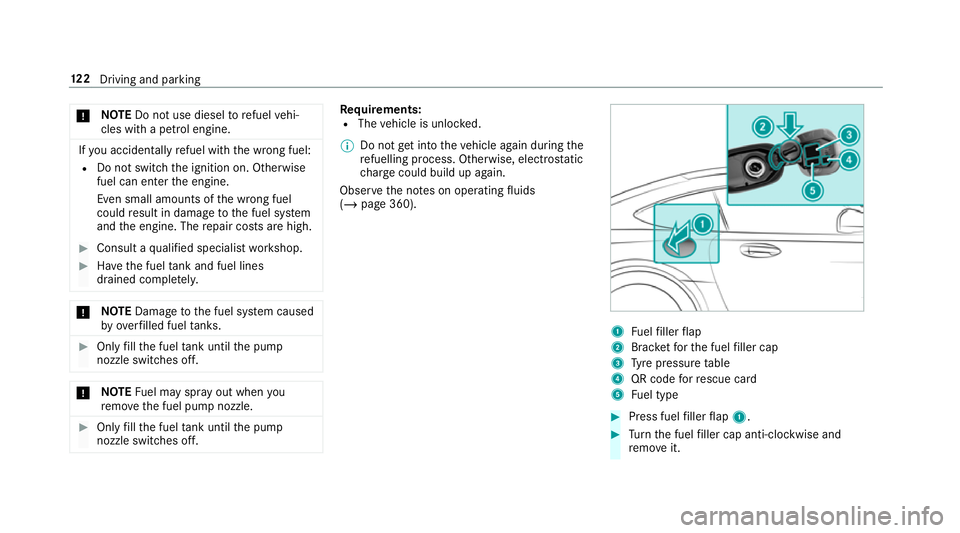
*
NO
TEDo not use diesel torefuel vehi‐
cles with a petrol engine. If
yo u acciden tally refuel with the wrong fuel:
R Do not switch the ignition on. Otherwise
fuel can enter the engine.
Even small amounts of the wrong fuel
could result in damage tothe fuel sy stem
and the engine. The repair costs are high. #
Consult a qualified specialist workshop. #
Have the fuel tank and fuel lines
drained compl etely. *
NO
TEDama getothe fuel sy stem caused
by ove rfilled fuel tanks. #
Only fill th e fuel tank until the pump
nozzle switches off. *
NO
TEFuel may spr ayout when you
re mo vethe fuel pump nozzle. #
Only fill th e fuel tank until the pump
nozzle switches off. Re
quirements:
R The vehicle is unloc ked.
% Do not get into theve hicle again during the
re fuelling process. Otherwise, electros tatic
ch arge could build up again.
Obser vethe no tes on operating fluids
(/ page 360). 1
Fuelfiller flap
2 Brac ketfo rth e fuel filler cap
3 Tyre pressure table
4 QR code forre scue card
5 Fuel type #
Press fuel filler flap 1. #
Turn the fuel filler cap anti-clockwise and
re mo veit. 12 2
Driving and pa rking
Page 134 of 465

and do not
relie ve you of your responsibility per‐
ta ining toroad traf fic la w.Pay attention tothe
traf fic conditions at all times and inter vene
when necessa ry. Be aware of the limitations
re ga rding the safe use of these sy stems. Information about
radar senso rs Some driving and driving sa
fety sy stems use
ra dar sensors tomonitor the area in front of,
behind or next totheve hicle (depending on the
ve hicle's equipment).
Depending on theve hicle's equipment, thera dar
sensors are integrated behind the bumpers
and/or behind the Mercedes star. Keep these
parts free of dirt, ice and slush (/ page314).
The sensors must not be co vered, forex ample
by cycle rack s, overhanging loads, sticke rs,fo il
or foils toprotect against stone chipping. In the
eve nt of dama getothe bumpers or radiator
grille, or following a collision impacting the
bumpers or radiator grille, ha vethe function of
th era dar sensors checked at a qualified special‐
ist workshop. The driver assis tance sy stem may
no longer workproperly. Overview of driving sy
stems and driving
saf ety sy stems In
this section, you will find information about
th efo llowing driving sy stems and driving saf ety
sy stems:
R ABS (A nti-lock Braking System)
(/ page 131)
R Active Dis tance Assi stDISTRONIC
(/ page 142)
R Adaptive Brake Lights (/ page137)
R AMG RIDE CONTROL (/ page151)
R Active Brake Assi st
R Lane Keeping Assist (/ page161)
R ATTENTION ASSIST (/ page157)
R BAS (B rake Assist System) (/ page132)
R Hill Start Assist (/ page146)
R EBD ( Electronic Brakeforc eDistribution)
(/ page 135)
R ESP ®
(Electronic Stability Program)
(/ page 132)
R HOLD fu nction (/ page 146) R
Limi ter (/ page139)
R Parking Assist PARKTRONIC (/ page152)
R Front and reve rsing camera (/ page154)
R RACE START (/ page 148)
R Cruise control (/ page 138)
R Blind Spot Assist (/ page160)
R Traf fic Sign Assi st (/ page 158) Fu
nction of ABS (Anti-lock Braking Sy stem) ABS
regulates the brake pressure in critical driv‐
ing situations:
R During braking, e.g. at full brake application
or insuf ficient tyre traction, the wheels are
pr eve nted from lo cking.
R Vehicle steerability while braking is ensured.
If ABS inter venes when braking, you will feel a
pulsing in the brake pedal. The pulsating brake
pedal can be an indication of hazardous road
conditions and can ser veas a reminder totake
ex tra care while driving. Driving and pa
rking 131
Page 140 of 465
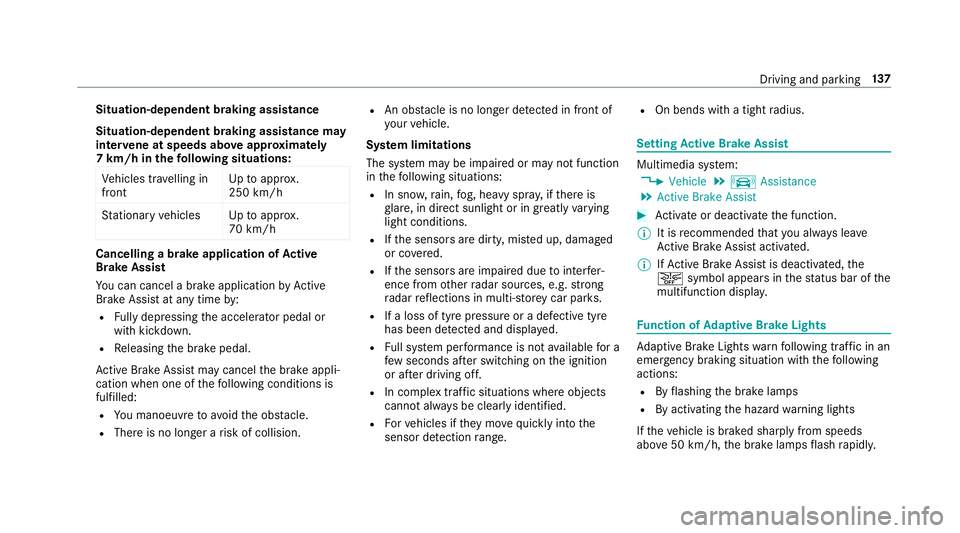
Situation-dependent braking assistance
Situation-dependent braking assistance may
inter vene at speeds abo veappr oxima tely
7 km/h in thefo llowing situations:
Ve hicles tr avelling in
front Up
toappr ox.
250 km/h
St ationary vehicles Uptoappr ox.
70 km/h Cancelling a brake application of
Active
Brake Assi st
Yo u can cancel a brake application byActive
Brake Assi stat any time by:
R Fully depressing the accelerator pedal or
with kickdown.
R Releasing the brake pedal.
Ac tive Brake Assi stmay cancel the brake appli‐
cation when one of thefo llowing conditions is
fulfilled:
R You manoeuv retoavoid the obs tacle.
R The reis no longer a risk of collision. R
An obs tacle is no longer de tected in front of
yo ur vehicle.
Sy stem limitations
The sy stem may be impaired or may not function
in thefo llowing situations:
R In sno w,rain, fog, heavy spr ay, if there is
gl are, in direct sunlight or in great lyvarying
light conditions.
R Ifth e sensors are dirty, mis ted up, damaged
or co vered.
R Ifth e sensors are impaired due tointer fer‐
ence from other radar sources, e.g. strong
ra dar reflections in multi-s torey car par ks.
R If a loss of tyre pressure or a defective tyre
has been de tected and displ ayed.
R Full sy stem per form ance is not available for a
fe w seconds af ter switching on the ignition
or af ter driving off.
R In complex traf fic situations whe reobjects
cannot always be clearly identified.
R Forve hicles if they mo vequickly into the
sensor de tection range. R
On bends wi tha tight radius. Setting
Active Brake Assi st Multimedia sy
stem:
4 Vehicle 5
k Assistance
5 Active Brake Assist #
Activate or deacti vate the function.
% It is recommended that you alw ays lea ve
Ac tive Brake Assi stactivated.
% IfAc tive Brake Assi stis deactivated, the
æ symbol appears inthest atus bar of the
multifunction displa y. Fu
nction of Adaptive Brake Lights Ad
aptive Brake Lights warnfollowing traf fic in an
emergency braking situation wi th thefo llowing
actions:
R Byflashing the brake lamps
R By activating the hazard warning lights
If th eve hicle is braked sharply from speeds
abo ve50 km/h, the brake lamps flash rapidl y. Driving and pa
rking 137
Page 142 of 465
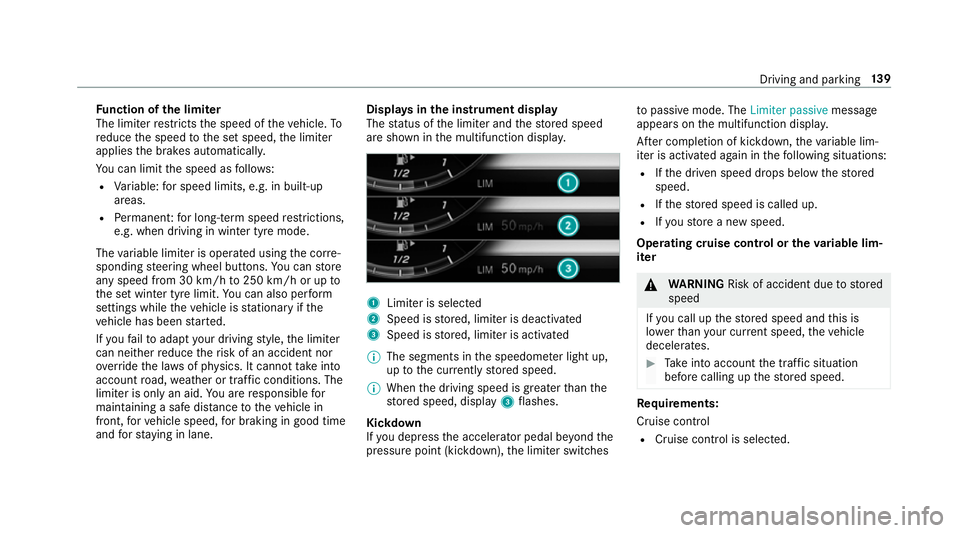
Fu
nction of the limiter
The limiter restricts the speed of theve hicle. To
re duce the speed tothe set speed, the limiter
applies the brakes automaticall y.
Yo u can limit the speed as follo ws:
R Variable: for speed limits, e.g. in built-up
areas.
R Perm anen t:for long-term speed restrictions,
e.g. when driving in winter tyre mode.
The variable limiter is operated using the cor re‐
sponding steering wheel buttons. You can store
any speed from 30 km/h to250 km/h or up to
th e set winter tyre limit. You can also per form
settings while theve hicle is stationary if the
ve hicle has been star ted.
If yo ufa ilto adapt your driving style, the limiter
can neither reduce therisk of an accident nor
ove rride the la wsof ph ysics. It cannot take into
account road, weather or traf fic conditions. The
limiter is only an aid. You are responsible for
maintaining a safe dis tance totheve hicle in
front, forve hicle speed, for braking in good time
and forst ay ing in lane. Displa
ysinthe instrument display
The status of the limiter and thestored speed
are shown in the multifunction displa y. 1
Limiter is selected
2 Speed is stored, limiter is deactivated
3 Speed is stored, limiter is activated
% The segments in the speedome ter light up,
up tothe cur rently stored speed.
% When the driving speed is greater than the
st ored speed, display 3flashes.
Kickd own
If yo u depress the accelerator pedal be yond the
pressure point (kickdown), the limiter switches to
passive mode. The Limiter passivemessage
appears on the multifunction displa y.
Af ter completion of kickdown, theva riable lim‐
iter is activated again in thefo llowing situations:
R Ifth e driven speed drops below thestored
speed.
R Ifth estored speed is called up.
R Ifyo ustore a new speed.
Operating cruise control or theva riable lim‐
iter &
WARNING Risk of accident due tostored
speed
If yo u call up thestored speed and this is
lo we rth an your cur rent speed, theve hicle
decelerates. #
Take into account the tra ffic situation
before calling up thestored speed. Re
quirements:
Cruise control
R Cruise control is selected. Driving and parking
13 9